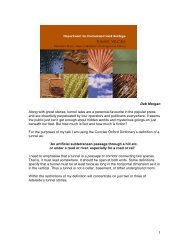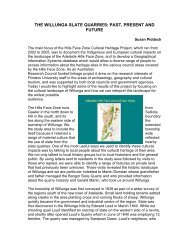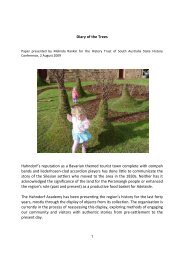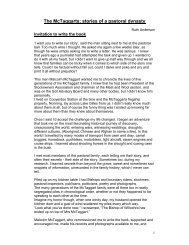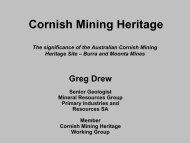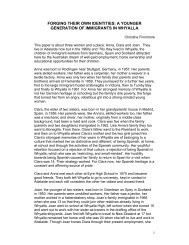Southward Bound Information - History SA
Southward Bound Information - History SA
Southward Bound Information - History SA
You also want an ePaper? Increase the reach of your titles
YUMPU automatically turns print PDFs into web optimized ePapers that Google loves.
Superintendent) However, in the prevailing uproar, when it was more than likely<br />
that the carpenters were still working on the accommodation and undoubtedly last<br />
minute cargo was being loaded, not to mention the stowing of the heavy baggage,<br />
the confusion, especially for a family from the country, must have been<br />
unbelievable.......<br />
The newly engaged crew would be working on deck: stewards were not provided<br />
for the steerage passengers and in any case how could one or two people<br />
possibly deal with the worries of two to three hundred migrants?<br />
The horror and or amazement of most to find that their world for at least the next<br />
three to four months was to comprise the area of the number of bunks allowed<br />
their family and a space at a rough trestle table along the centre of the quarters, is<br />
impossible to convey in print. The total area comprised the bunks and a few feet of<br />
space alongside one side of the bunks and the space under the lower berth -<br />
about as much as is allowed these days in economy class sleeping berths on long<br />
distance trains!<br />
Here the migrant family was to exist on a voyage expected to take at best about<br />
100 days! The suggestion is completely beyond the comprehension of most<br />
present day travellers.<br />
THE SHIPS<br />
Types<br />
As iron and other metals were generally not used in ship building until after 1855,<br />
the early south Australian migrant ships were all made of wood and they were all<br />
sailing ships. The type of ship was determined by the arrangement of the masts<br />
and sails commonly called the rigging.<br />
The four most common vessels were -<br />
Barque: a sailing vessel with 3 masts, fore and main masts were square rigged<br />
and the mizzen mast was fore and aft rigged.<br />
Brig: a two masted vessel square rigged on both fore and main masts.<br />
Schooner: a sailing vessel with two or more masts fore and aft rigged on each<br />
mast. Originally a schooner carried square top sails on fore mast.<br />
Ship (strict maritime usage): a vessel with a bow sprit and three masts each with a<br />
top mast and topgallant mast and square rigged on all three masts.<br />
Terms:<br />
The few total losses recorded for migrant ships despatched to South Australia<br />
suggests a high standard of vessel being used. However many ships which plied<br />
the route were unsuitable for a voyage which took them into the Southern Ocean<br />
and the roaring forties an area of winds which forced them on their sides and<br />
pushed them through mountainous seas often for days or weeks on end.<br />
ACCOMMODATION



